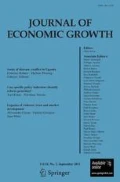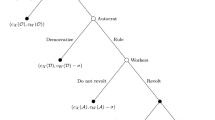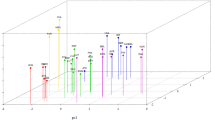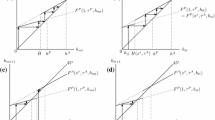Abstract
We use an OLG model to examine democratic choice betweentwo modes of government support for education: subsidies forprivately purchased education and free uniform public provision.We find little conflict between democracy and growth: the samefactors that generate popular support for subsidization overfree uniform provision—large external benefits, a largeexcess burden, and little inequality—also favor its relativegrowth performance. Furthermore, restricting the franchise toan upper-income elite may also reduce growth. Two extensionsexamine the effect of intergenerational mobility and indicatethe theoretical possibility of periodic swings in the balancebetween public and private spending.
Similar content being viewed by others
References
Aitchison, J., and J. A. C. Brown. (1969). The Lognormal Distribution. London: Cambridge University Press.
Alesina, A., and D. Rodrik. (1994). “Distributive Politics and Economic Growth,” Quarterly Journal of Economics, 109, 465–490.
Azariadis, C., and A. Drazen. (1990). “Threshold Externalities in Economic Development,” Quarterly Journal of Economics, 105, 501–526.
Barro, R. (1991). “Economic Growth in a Cross-Section of Countries,” Quarterly Journal of Economics, 106, 406–443.
Barro, R. (1996). “Democracy and Growth,” Journal of Economic Growth, 1, 1–27.
Benabou, R. (1995). “Unequal Societies,” Manuscript.
Benabou, R. (1996). “Heterogeneity, Stratification, and Growth: Macroeconomic Implications of Community Structure and Public Finance,” American Economic Review89, 584–609.
Bergstrom, T., D. Rubinfeld, and P. Shapiro. (1982). “Micro-Based Estimates of Demand Functions for Local School Expenditures,” Econometrica50, 1183–1205.
Boldrin, M. (1993). “Public Education and Human Capital Accumulation,” DP 1017, Kellogg Graduate School of Management, Northwestern University.
Devarajan, S., D. Xie, and H.-F. Zou. (1996). “Should Public Capital Be Subsidized or Provided?, Working Paper.
Eckstein, Z., and I. Zilcha. (1994). “The Effects of Compulsory Schooling on Growth, Income Distribution and Welfare,” Journal of Public Economics54, 339–359.
Epple, D., and R. Romano. (1996). “Ends Against the Middle: Public Provision of Private Services,” Journal of Public Economics.
Fernandez, R., and R. Rogerson. (1996). “Income Distribution, Communities, and the Quality of Public Education,” Quarterly Journal of Economics111, 135–164.
Galor, O., and D. Tsiddon. (1997). “The Distribution of Human Capital and Economic Growth,” Journal of Economic Growth2, 93–124.
Galor, O., and J. Zeira. (1993). “Income Distribution and Macroeconomics,” Review of Economic Studies60, 35–52.
Glomm, G., and B. Ravikumar. (1992). “PublicVersus Private Investment in Human Capital: Endogenous Growth and Income Inequality,” Journal of Political Economy100, 818–834.
Glomm, G., and B. Ravikumar. (1995). “Vouchers, Public and Private Education, and Income Distribution,” Working Paper, Michigan State University.
Gradstein, M., and M. Justman. (1996). “The Political Economy of Mixed Public and Private Schooling: A Dynamic Analysis,” International Tax and Public Finance3, 297–310.
Hirschman, A. O. (1981). Shifting Involvements. Princeton, NJ: Princeton University Press.
Huffman, G. W. (1996). “Endogenous Tax Determination and the Distribution of Wealth,” Carnegie-Rochester Series on Public Policy45, 207–242.
James, E. (1993). “Why Do Different Countries Choose a Different Public-Private Mix of Educational Services?,” Journal of Human Resources28, 572–592.
Krusell, P., V. Quadrini, and J.-V. Rios-Rull. (1994). “Politico-Economic Equilibrium and Economic Growth,” CARESS WP 94-11, University of Pennsylvania. Also in Journal of Economic Dynamics and Control21, 243–272.
Lott, J. (1990). “An Explanation for Public Provision of Schooling: The Importance of Indoctrination,” Journal of Law and Economics33, 199–231.
Loury, G. (1981). “Intergenerational Transfers and the Distribution of Earnings,” Econometrica49, 843–867.
Lucas, R. E., Jr. (1988). “On the Mechanics of Economic Development,” Journal of Monetary Economics22, 3–42.
Perotti, R. (1996). “Growth, Income Distribution and Democracy,” Journal of Economic Growth1, 149–187.
Persson, T., and G. Tabellini. (1994). “Is Inequality Harmful for Growth? Theory and Evidence,” American Economic Review84, 600–621.
Ranis, G. (1990). “Contrasts in the Political Economy of Development Policy Change,” in G. Gereffi and D. Wyman (eds.), Manufacturing Miracles: Paths of Industrialization in Latin America and East Asia. Princeton, NJ: Princeton University Press.
Romer, P. M. (1986). “Increasing Returns and Long-run Growth,” Journal of Political Economy94, 1002–1037.
Rustichini, A., A. Ichino, and D. Checchi. (1996). “More Equal But Less Mobile? Education Financing and Intergenerational Mobility in Italy and in the U.S.,” Working Paper.
Saint-Paul, G., and T. Verdier. (1993). “Education, Democracy and Growth,” Journal of Development Economics 42, 399–407.
Stiglitz, J. E. (1988). The Economics of the Public Sector(2nd ed.). New York: Norton.
Stiglitz, J. E. (1974). “The Demand for Education in Public and Private School Systems,” Journal of Public Economics3, 349–385.
Author information
Authors and Affiliations
Rights and permissions
About this article
Cite this article
Gradstein, M., Justman, M. Democratic Choice of an Education System: Implications for Growth and Income Distribution. Journal of Economic Growth 2, 169–183 (1997). https://doi.org/10.1023/A:1009781101707
Issue Date:
DOI: https://doi.org/10.1023/A:1009781101707




